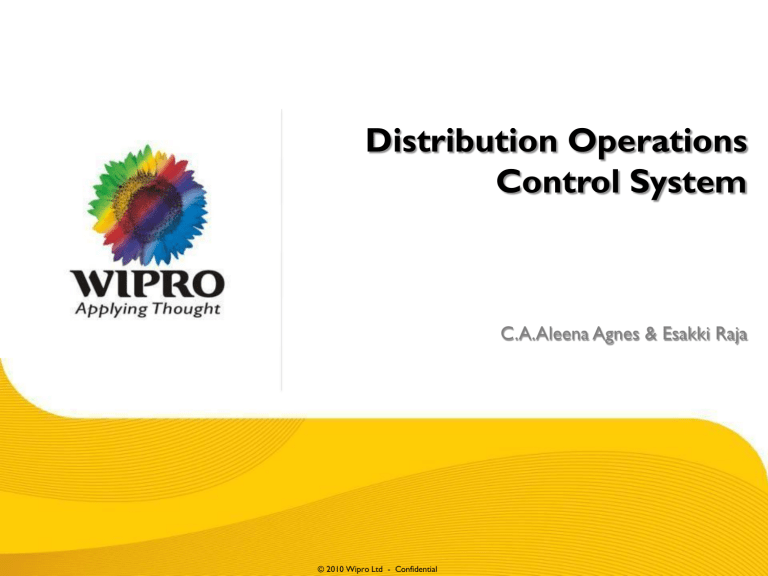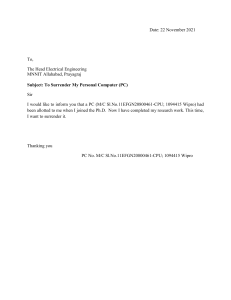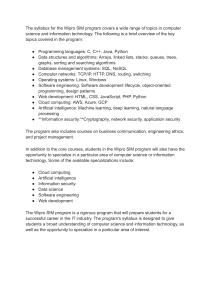
Distribution Operations Control System C.A.Aleena Agnes & Esakki Raja © 2010 Wipro Ltd - Confidential Agenda 1 Introduction 2 Application Overview 3 Business Process 2 © © 2010 2010 Wipro Wipro Ltd Ltd -- Confidential Confidential Introduction 3 © 2010 Wipro Ltd - Confidential Introduction VF Corporation is a worlwide leader in branded apparel and related products with a vision to grow by building lifestyle brands that would excite the consumers around the world. The various areas of business of VF Corp are imagewear, sportswear, jeanswear, outdoor and contemporary brands. VF has managed exceptional capabilities related to consumer research, inventory management, flow replenishment, sourcing and technology, all of which help in ensuring the right products for their customers and retail partners by knowing where and when they want them. VF has a strong business model that has led it to a strong and consistent performance over any decades. 4 © © 2010 2010 Wipro Wipro Ltd Ltd -- Confidential Confidential Application Overview 5 © 2010 Wipro Ltd - Confidential Application Overview DOCS is a system to control the inventory in the DC & provide the capability to ship to customers on a timely basis. It is an integrated, custom system that interacts with the DC employees, portable RF terminals, and material handling equipments such as conveyors and scanning stations. DOCS executes primarily on an RS/6000 located in the distribution center but also interfaces heavily with the mainframe, a PC that drives the tilt tray sorter, PLC’s which drive the conveyors and devices which provide communication with the RF equipment. There are six main functional layers to support six primary operational areas within the DC such as receiving, order scheduling, replenishment, order picking, shipping and inventory control. 6 © © 2010 2010 Wipro Wipro Ltd Ltd -- Confidential Confidential Business Processes 7 © 2010 Wipro Ltd - Confidential Overview of Business Processes DOCS is divided into six functional areas to support six primary operational areas within the distribution centre. There is an additional area referred to as Systems Operations which refers to items such as security, interfaces with the other platforms. Receiving – Automatic via conveyors and scanners – Pre-notification is provided via the mainframe – ‘Carton Create’ functionality & QC Audit Capability for inbound inventory. Order scheduling – Automates order selection and prioritizing process – Online function for selection of orders for the schedule building of waves – Wave initiation function & prints pick tickets & bill of lading 8 © © 2010 2010 Wipro Wipro Ltd Ltd -- Confidential Confidential Overview of Business Processes (Contd..) Replenishment – System management of random storage carton inventory. – RF directives to replenishment operators to let down random storage inventory to replenish pick runs. Order picking – Capability of dynamic pick runs. – Ability to quickly resolve picking errors. – Tracks shipping cartons & update inventory locations throughout the picking process. 9 © © 2010 2010 Wipro Wipro Ltd Ltd -- Confidential Confidential Overview of Business Processes (Contd..) Shipping – Automatically print shipping documents. – Capability of reporting a shipment complete. Inventory control – Cycle counting capability for random storage and fixed picking runs. – Record all inventory transactions. – Batch uploads to the mainframe of all inventory and shipment information 10 © © 2010 2010 Wipro Wipro Ltd Ltd -- Confidential Confidential Receiving 11 © 2010 Wipro Ltd - Confidential Overview of receiving The objective of receiving is to effectively initiate, control, and track the receipt of goods into the DC. Receiving is initiated by the arrival of an inbound shipment at the DC. They come from sewing and finishing plants, outside storage facility, from other DC’s, returns from the retailers or from other contractors. Merchandise typically enters the DC in one dozen(OD), two dozen(TD) or in large puerto rican(PR) containers. All the return merchandise from the customer and irregular merchandise from other plants have generic bar code which helps in diverting it to the return area. Prenotified cartons received are known through the mainframe. The cartons which are not prenotified are entered into the DC’s informational database, where this process is called as Carton Creation. 12 © © 2010 2010 Wipro Wipro Ltd Ltd -- Confidential Confidential Overview of receiving ( Contd..) The unloaded cartons are put into the receiving conveyor and sending the carton to the receiving scanner and it will scan the bar code identification and weigh the carton. The DOCS system determines whether it is known to the system and if it is within the computed weight tolerance. If it is, it is send to the Quality Control (QC) audit area based on the parameters and then logically it is received into the DC. If scanner could not read the bar code identification it is automatically sent to the no-read area where some human intervention is required. 13 © © 2010 2010 Wipro Wipro Ltd Ltd -- Confidential Confidential Overview of receiving ( Contd..) 14 © © 2010 2010 Wipro Wipro Ltd Ltd -- Confidential Confidential Order scheduling 15 © 2010 Wipro Ltd - Confidential Overview of Order Scheduling The objective of order scheduling is to provide the picking, replenishment and shipping workloads for the DC while filling customer requirements for orders. This work has to be done as efficiently as possible given the makeup of the customer orders that are being processed and the availability of the stock in the DC. The Order Scheduling process consists of three major components – Order Selection : This is the process where the customer orders are selected according to stock availability and schedule dates using on-line screen. – Wave Initialization/Initiation - This is the process where the schedule parameters such as the number of waves, case selection method, and wavespreading parameters are set. – Order Scheduling Batch Process -. This process spreads the shipping cartons among the waves of the schedule according to the parameters that were set in the wave initialization. 16 © © 2010 2010 Wipro Wipro Ltd Ltd -- Confidential Confidential Order Scheduling Components 17 © © 2010 2010 Wipro Wipro Ltd Ltd -- Confidential Confidential Replenishment 18 © 2010 Wipro Ltd - Confidential Overview Of Replenishment The objective of replenishment is to provide an efficient means of replacing product in the picking areas. Replenishment provides functionality for managing product stored within random storage, outside storage and pallet storage areas. It also controls the removal of goods from storage areas for reasons such as Quality Control Audit and relocation to other areas of storage. Pick Run replenishment is a process of removing cartons of goods from random storage and sending the goods to the pick runs where they are needed to fill customer orders. Replenishment requirements are determined in Order Scheduling, where the specific storage cartons needed for a picking wave are identified. The contents of the carton which are picked for the needs are replenished by putting back the required cartons which were taken. In a manual DOCS facility there is no conveyor system or tilt-tray sorter for pick run replenishment. Pulled cartons are delivered to a designated location. 19 © © 2010 2010 Wipro Wipro Ltd Ltd -- Confidential Confidential Replenishment Overview 20 © © 2010 2010 Wipro Wipro Ltd Ltd -- Confidential Confidential Order Picking 21 © 2010 Wipro Ltd - Confidential Overview Of Order Picking The objective of picking is to accurately fill the demand of scheduled orders at the carton level and prepare the merchandise for shipment. The cartons are processed through Ultra-Pick, Carton Flow and Static Shelf picking areas in the DC and routing the cartons through Special Operations and ultimately to the shipping/staging areas. A carton is created in the area because the first pick into the carton is to be made in this area. A carton is transported via conveyor from another pick area because a single pick area could not completely satisfy the pick requirements for the carton. In a fully automated DC, movement of cartons between areas is accomplished via powered conveyors. In a manual DC, movement of cartons can be either manual or by conveyor. 22 © © 2010 2010 Wipro Wipro Ltd Ltd -- Confidential Confidential Overview Of Order Picking Picking process : – DOCS prints all the necessary pick documents and shipping labels as soon as order are ready to be filled. – They will print in a central location and be distributed to the pickers. – Before the start of each schedule, the pick documents will be sorted by wave and picking area and will be put in groups depending upon the picking areas. There are different ways of picking such as directed picking, cluster picking, pick bin adjustment, carton combining, UPC inquiry and exception picking. 23 © © 2010 2010 Wipro Wipro Ltd Ltd -- Confidential Confidential Shipping 24 © 2010 Wipro Ltd - Confidential Overview of Shipping When customer orders are received DOCS automatically print shipping documents necessary for the shipping the required cartons. Shipping is done either RF based or terminal based in the distribution centre. Loading done for shipping cartons are done through trailer loading and fluid loading. Standard loading function is used to notify DOCS when a trailer is fully loaded or a shipment is complete. By entering the bill of lading number one could know the entire details of the shipment materials and where it is delivered it to. Capability of reporting whether the shipment is complete. 25 © © 2010 2010 Wipro Wipro Ltd Ltd -- Confidential Confidential Inventory Control 26 © 2010 Wipro Ltd - Confidential Overview OF Inventory Control Cycle counting capability is there for random storage and fixed picking runs. The products in the Random Reserve locations are cycle counted only for the number of cartons in the location. All the transactions and shipping done are recorded for the reference. The cycle counting random reserve locations is a two step process: – The user just scans all the available cartons in the location. – The user audits the discrepancies in the location. If the system sees any discrepancy between the scanned and the available data, the system will ask the user to scan the neighboring locations’ cartons. If the carton is found in one of those locations then the system updates the carton’s location to the new location. Incase the carton is nowhere to be seen in any of those locations then the carton’s location is set to one of those logical locations where it is not available for picking. 27 © © 2010 2010 Wipro Wipro Ltd Ltd -- Confidential Confidential Other System Operations 28 © 2010 Wipro Ltd - Confidential Other System Operations End-of-Day Processing: – DOCS requires a two-hour window each day to shutdown the system, back up files and reboot the system. This is referred to as “End-of-Day.” – Timing of this process is up to the individual DC, but it is important that it be done daily to minimize the risk of losing data in the event of a system problem and to allow back-up and summarization of data for reports, etc. – Normal end-of-day is a three-step process: • Shut down: Ends all processes, backs up the database and reboots the system. • Startup : Restarts processes, unloads the database to a tape, performs system balancing and creates an archive. • Report: Generates daily reports. – Each of these steps must run to completion and must be run in the proper sequence. 29 © © 2010 2010 Wipro Wipro Ltd Ltd -- Confidential Confidential Thank You © 2010 Wipro Ltd - Confidential


